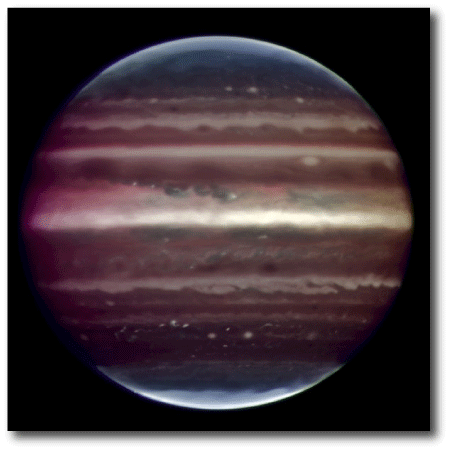
With the flood of detail from extrasolar planets, one can forget that our knowledge of the worlds in our own solar system is literally centuries ahead of what we know about planets orbiting other stars. For example, careful naked-eye observations can be used to derive better orbital models for Venus et al. than we currently possess for any exoplanet (assuming, of course, that one owns a good watch and eyesight sufficient to resolve the disk of Venus when it transits the Sun). One of the best ways to learn about what’s out there is to learn as much as we can about what’s right here.
In this vein, an important paper came out in Nature last summer, in which Lainey et al describe a direct and unprecedentedly accurate measurement of the present value of Jupiter’s tidal quality factor, Q. The tidal quality factor encapsulates the ability of an object to dissipate disturbances raised by tidal gravity. The lower the Q, the more capable is the body at damping out the perturbations generated by tidal forcing. Q can depend quite sensitively on the frequency at which perturbations occur, and with a few notable exceptions (for example, the Earth and the Moon), it is notoriously tricky to determine. Previous estimates for Jupiter’s Q ranged from Q~60,000 to over a million. By extension, Q values for Jupiter-mass extrasolar planets are often assumed to lie in this range.
In order to directly measure the Jovian Q, Lainey et al. adopted a procedure that’s conceptually very similar to what goes on inside the systemic console. They first collected measurements of the positions of the galilean satellites that were obtained from 1891 all the way through 2007. They then constructed an orbital N-body model that includes the full gravitational forces acting on Jupiter and the galilean satellites, and which incorporates the non-axisymmetric gravitational pulls exerted by the tidal bulges of Jupiter and Io. The fitted parameters — that is, the initial conditions and undetermined constants — for their model are the osculating orbital elements of the moons, and the values of Q/k2 for Jupiter and Io. (The Love number, k2, is a measure of the degree of central concentration of a body, and has a value of k2~0.37 for Jupiter. For more, see these posts, one, two, from last summer).
Lainey et al. varied the parameters and repeatedly carried out new integrations until the the agreement between where the integrated orbital model said the moons should be located and where they were actually observed was optimized. For this type of direct integrations, goodness-of-fit is highly sensitive to the amount of tidal dissipation in Io and in Jupiter — the larger the dissipation, the larger the effect on the orbit. As a consequence, when a best-fit orbital model is attained, one has direct estimates for the Q‘s of both Jupiter and Io.
And the result? The integrations suggest that the current value of Jupiter’s Q is of order 30,000. This suggests that Jupiter is much more dissipative than has been assumed, and is indeed quite comparable to Neptune or Uranus in terms of its ability to damp out tidal disturbances. The measured Q is low enough, in fact, to suggest that Jupiter currently lies in a state where the tidal forcing by Io is leading to a historically large rate of dissipation. Over the past several billion years, as the orbital frequencies of Io, Europa and Ganymede evolved through a range of values, Jupiter’s Q was on average likely quite a bit higher than it is now.
Jupiter’s low Q hints that the transiting Neptune-mass planet Gliese 436b is even more mysterious than previously though. Gliese 436b has a significantly eccentric orbit whose non-circular figure can only be understood if (1) there’s a suitably influential perturber in the system, or (2) there was a relatively recent disaster, or (3) if the planetary Q has somehow stayed anomalously high through billions of years of orbital evolution. No matter which one of these possibilities turns out to be correct, it’ll be a very interesting story.


